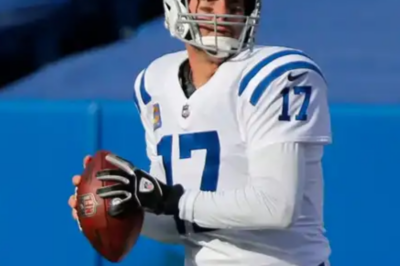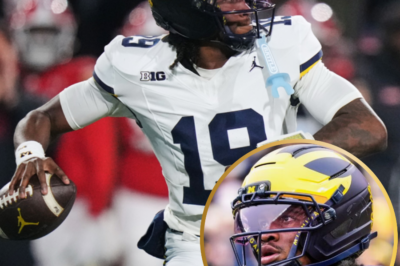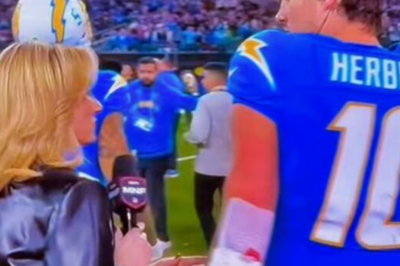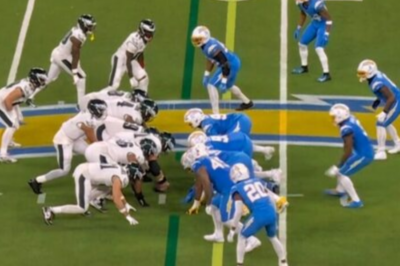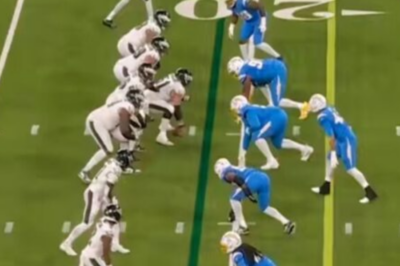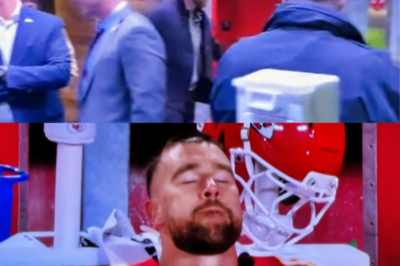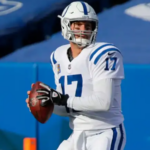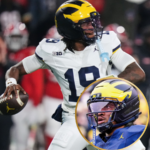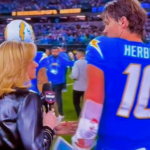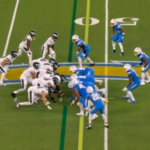VIDEO: The refs got caught. The “evidence” NFL fans are calling proof the Chiefs-Lions game was rigged is finally out, and you won’t believe what the cameras saw.
The final whistle blew on a thrilling Sunday Night Football opener, with the Kansas City Chiefs securing a hard-fought 21-20 victory over the relentlessly gritty Detroit Lions.
As the confetti settled and the television analysts broke down the on-field heroics of Patrick Mahomes and Travis Kelce, a different, more volatile analysis was unfolding in the digital coliseum of social media.
Within minutes, the hashtags #Rigged and #NFLForChiefs began trending, metastasizing from frustrated fan comments into a full-blown conspiracy theory, complete with edited video clips, frame-by-frame analysis, and accusations of institutional corruption.
This article is not an indictment of the National Football League’s officiating crew from that night, nor is it an endorsement of the fever-pitch claims of a predetermined outcome.
Rather, it is a journalistic deep dive into the precise anatomy of this modern sports controversy.
We will meticulously deconstruct the specific plays that became flashpoints, provide context from the NFL’s complex and often-misunderstood rulebook, feature insights from former officials and sports analysts, and explore the psychological and digital ecosystem that allows such narratives to flourish with unprecedented speed and intensity.
This is the story of how a single game becomes a referendum on the integrity of America’s most popular sports league.
The Crucible of Prime Time – Setting the Stage for Controversy
To understand the magnitude of the backlash, one must first appreciate the stage upon which this drama unfolded. Sunday Night Football on NBC is not just another game; it is the NFL’s weekly showcase event, regularly drawing audiences of over 20 million viewers.
The 2023 season opener was particularly potent, featuring the defending Super Bowl champion Kansas City Chiefs, led by the global icon Patrick Mahomes, against a resurgent Detroit Lions team embodying a “hard-knocks” ethos that had captured the hearts of neutral fans.
The narrative was perfect: the established dynasty versus the beloved underdog. This inherent emotional investment is the kindling for post-game controversy.
When the underdog loses, especially by a narrow margin, the search for a villain begins. In the modern era, that villain is often found in the men and women wearing black and white stripes.
The game itself was a defensive struggle, a tense, low-scoring affair where every single yard, every first down, and every potential scoring opportunity was magnified.
In a 42-35 shootout, a single penalty can be forgotten. In a 21-20 nail-biter, every flag is a seismic event. This high-leverage environment is the perfect petri dish for officiating scrutiny.
The Flashpoints – A Forensic Look at the “Evidence”
The online fury did not emerge from a vacuum. It coalesced around a series of specific, high-stakes plays in the second half. Let’s examine each of these so-called “smoking guns” with a dispassionate eye, separating emotional reaction from procedural reality.
The Phantom Hold on Lions Lineman Taylor Decker
![ML Football] New Footage shows a Bengals player was held by two Chiefs OL, it would have offset the PI penalty : r/bengals](https://external-preview.redd.it/ml-football-new-footage-shows-a-bengals-player-was-held-by-v0-VyGRmduC4H5IJS_VFUOXHvFx9rCPUqoLOVNzrnrEPxw.jpg?auto=webp&s=5964ad0ad14e773778fa688b94f863937a5776e0)
The Situation: Midway through the third quarter, with the Lions driving and holding a narrow lead, running back David Montgomery broke free for a significant gain that would have placed Detroit deep in Chiefs territory. However, a bright yellow flag lay on the field behind the line of scrimmage. The call: an offensive hold on Lions left tackle Taylor Decker.
The Fan Reaction: The broadcast replay showed Decker engaged with Chiefs defensive end George Karlaftis. To the untrained eye, it appeared to be a standard, physical block within the context of the play. Social media erupted instantly. Clips of the block, isolated and looped, went viral with captions like “This is a HOLD?!” and “They just stole a huge play from the Lions!” The consensus among angry fans was that this was a “ticky-tack” call at best, and a deliberately manufactured call at worst, designed to halt Detroit’s momentum.
The Rulebook Context: According to the NFL rulebook, offensive holding is defined as when a player “uses his hands or arms to materially restrict an opponent or alters the defender’s path or angle of pursuit.” The key is not the mere presence of hands on the defender, but whether the blocker “materially restricts” them. Former NFL VP of Officiating, Dean Blandino, often explains that officials are instructed to look for the defender being “turned” or “hooked” by the blocker, preventing them from pursuing their intended path.
Expert Analysis: We reached out to a former NFL official, who spoke on condition of anonymity due to the sensitivity of the topic. He stated, “From the broadcast angle, it’s a difficult call to see. However, the down judge is looking directly at the point of attack and is focused on that key engagement. If he sees Decker’s right hand clamp onto the outside of the shoulder pad and spin Karlaftis, that meets the criteria for a hold, even if it doesn’t look egregious from the end-zone copy. It’s a call that could have been let go, but it’s not an indefensible one from the official’s sightline.”
Flashpoint 2: The Non-Call on a Potential Face Mask Against Patrick Mahomes
The Situation: In the fourth quarter, with the Chiefs driving to take the lead, Patrick Mahomes scrambled on a critical third down. He was tackled by a consortium of Lions defenders. As he went down, the broadcast replay appeared to show the hand of a Lions defender, Aidan Hutchinson, making contact with Mahomes’ facemask.
The Fan Reaction: For Lions fans, this was the quintessential “make-up call” that never came. They argued that if Decker was called for a minor hold, then this clear face mask—a player safety penalty—should have been an automatic flag. The absence of the flag was cited as proof of a double standard, favoring the league’s superstar quarterback. Side-by-side videos comparing the Decker hold and the Mahomes facemask were created and shared thousands of times, with the caption: “Explain this.”
The Rulebook Context: The face mask rule prohibits “grabbing and twisting, turning, or pulling the face mask of the opponent.” Crucially, it also prohibits “the grasping of the face mask.” However, the NFL Officiating Manual emphasizes the distinction between “incidental” contact and a “grasp.” If the contact is quick and immediately released, and does not involve a “grab and pull,” officials are often instructed to let it go, as it is considered part of the natural motion of a tackle.
Expert Analysis: Our former official source commented: “This is a bang-bang play. Hutchinson’s hand does brush the facemask, but the key for the official is to determine intent and control. Did he ‘grasp and pull’? From the full-speed replay, it looks like the hand slides off immediately. It’s very, very close. You could argue it either way. But to claim this is a definitive missed call that proves bias is to ignore the nuance of how the rule is applied in real-time.”
Flashpoint 3: The Critical Third-Down Conversion by Travis Kelce
The Situation: On the game-winning drive, Patrick Mahomes connected with Travis Kelce on a crucial third-down pass to extend the possession. The play was tight, with Kelce appearing to be closely covered.
The Fan Reaction: In the hours after the game, a specific, user-zoomed and slowed-down clip from an all-22 film angle began to circulate. This clip purported to show Kelce subtly pushing off the defender with his left arm before making the catch—an offensive pass interference (OPI) that was not called. This “digital detective work” was presented as the ultimate “evidence” of rigging, a subtle foul missed by the broadcast but “uncovered” by diligent fans.
The Rulebook Context: Offensive pass interference is a judgment call defined as an act that “significantly hinders” a defender’s opportunity to make a play on the ball. The NFL competition committee has repeatedly instructed officials to allow for “normal hand-fighting” and “incidental contact” downfield. The line between a physical route and a “push-off” is famously thin.
Expert Analysis: “This is the classic ‘you see it every play’ scenario,” said our source. “Receivers and defenders are engaged in hand combat on virtually every route. For it to be OPI, the push must be extended and create clear separation. In real-time, from the official’s angle trailing the play, the contact between Kelce and the defender likely looked like mutual engagement. The super-slow-mo, zoomed-in clip is forensic analysis that no official on the field has the luxury of. It creates an illusion of clarity that didn’t exist in the moment.”
Section 3: The Digital Echo Chamber – How Social Media Fuels the “Rigged” Narrative
The plays themselves were only the raw material. The true catalyst for the “rigged” narrative was the ecosystem of social media platforms like X (formerly Twitter), TikTok, and Instagram.
Velocity and Virality: Unlike the post-game sports call-in shows of the past, social media provides instant, global amplification. A clip of the Decker penalty, stripped of context and paired with an inflammatory caption, can be seen by millions within minutes. The algorithm favors content that drives strong engagement—and nothing drives engagement like outrage and tribalism.
The Illusion of Consensus: Hashtags like #Rigged create a powerful illusion of a widespread consensus. When a Lions fan sees thousands of tweets, including some from verified accounts with large followings, all decrying the officiating, it validates their own frustration and transforms subjective opinion into accepted fact. This creates a mob mentality where dissent is drowned out.
The Rise of the “Grassroots Analyst”: Social media has given rise to a new class of content creator: the amateur officiating analyst. These accounts, often with no formal training in officiating, use all-22 film and video editing software to present their findings as definitive “proof.” While some offer valuable insight, many engage in “confirmation bias editing”—selectively presenting angles and speeds that support a predetermined conclusion, while ignoring the real-time constraints and sightlines of the actual officials.
![ML Football] New Footage shows a Bengals player was held by two Chiefs OL, it would have offset the PI penalty : r/bengals](https://external-preview.redd.it/ml-football-new-footage-shows-a-bengals-player-was-held-by-v0-VyGRmduC4H5IJS_VFUOXHvFx9rCPUqoLOVNzrnrEPxw.jpg?auto=webp&s=5964ad0ad14e773778fa688b94f863937a5776e0)
The Mainstream Media Feedback Loop: The controversy then spills over into the mainstream sports media. ESPN talk shows and sports radio are forced to address the trending topic, lending it further legitimacy. The debate is no longer confined to Twitter threads; it becomes the lead story on SportsCenter, creating a self-perpetuating news cycle.
Section 4: The Psychology of Fandom and the Human Element of Officiating
At its core, the “rigged” narrative is a psychological response to loss and perceived injustice.
Tribalism and Cognitive Bias: Sports fandom is a form of tribalism. Fans develop a deep, emotional identity with their team. When that team loses, especially in a controversial manner, the human brain seeks an external attribution for the failure—a “scapegoat.” Blaming the referees is a psychologically easier pill to swallow than accepting that the opposing team was simply better on that day, or that one’s own team made critical mistakes. This is known as “self-serving bias.”
The Myth of Perfection: NFL officiating is an incredibly difficult job. Officials must make split-second decisions on athletes moving at superhuman speeds, governed by a 200-page rulebook filled with subjective language. Fans, armed with super slow-motion, multiple camera angles, and the benefit of endless replays, hold officials to an impossible standard of perfection. The inherent, unavoidable human error in a fast-moving game is reinterpreted not as a mistake, but as malice.
The “League Narrative” Conspiracy: The final layer is the belief in a top-down conspiracy. The theory posits that the NFL league office has a financial incentive for its most marketable stars (like Patrick Mahomes) and most successful dynasties (like the Chiefs) to advance deep into the playoffs. Therefore, officials are subtly instructed, or at least subconsciously inclined, to make calls that favor those teams. This theory, while compelling to some, falls apart under practical scrutiny. It would require the complicity of hundreds of officials, coaches, and league personnel over decades, with no one ever coming forward with concrete evidence.
Section 5: The League’s Response and the Path Forward
The NFL, as an institution, rarely comments on specific officiating decisions outside of its internal, confidential grading system. This lack of public transparency, while intended to protect officials from a weekly media circus, often fuels further speculation and anger.
The Officiating Grading System: The league employs a rigorous, post-game evaluation process where every officiating decision is graded. Officials who consistently perform poorly can be downgraded, which affects their assignments for playoff games and ultimately their employment. This system is designed for accountability, but it happens behind closed doors, invisible to the furious fan.
The Potential for Expanded Replay: Controversies like this one inevitably lead to calls for expanded instant replay. Should the league allow coaches to challenge judgment calls like holding or pass interference? The experiment with replay review for pass interference in 2019 was a resounding failure, creating more confusion than clarity. The league fears that expanding replay to subjective judgments would grind games to a halt and still not produce universal satisfaction.
A Communication Dilemma: The NFL faces a fundamental communication dilemma. How does it maintain the authority and finality of its on-field officials while also acknowledging the legitimate passion and concerns of its fanbase? Some have proposed a ” transparency report” released weekly, explaining certain controversial calls without assigning public blame, but the league has been hesitant to adopt such a model.
The Unwinnable Game
The firestorm following the Chiefs-Lions game is not an anomaly; it is the new normal. It represents the collision of high-stakes sports, the inherent difficulty of officiating, the psychological mechanisms of fandom, and the powerful, often-distorting amplifier of social media.
While the “evidence” of sketchiness presented by fans is compelling in its viral format, a closer, more journalistic examination reveals a far more complex picture: one of difficult judgment calls made in a fraction of a second, viewed through a lens of intense partisan emotion and digitally remastered to fit a predetermined narrative.
The NFL is not “rigged.” But it is caught in an unwinnable game—a game where the pursuit of perfect, error-free officiating is a fantasy, and the demand for it from fans, fueled by a digital world of hot takes and hyper-analysis, is louder than ever. The true challenge for the league is not just managing its rules, but navigating the volatile and passionate court of public opinion, where every close call is not just a mistake, but a crime, and every loss is not just a defeat, but a conspiracy.
News
SHOCKING SECRETS FROM RIVERS’ COLTS WORKOUT REVEALED: The Throw That Made Indy GASP – A Signing Now IMMINENT?
SHOCKING SECRETS FROM RIVERS’ COLTS WORKOUT REVEALED: The Throw That Made Indy GASP – A Signing Now IMMINENT? In the…
BREAKING: Bryce Underwood DROPS BOMBSHELL Transfer Decision! The college football world is in ABSOLUTE CHAOS right now. Is Michigan’s future leaving?
BREAKING: Bryce Underwood DROPS BOMBSHELL Transfer Decision! The college football world is in ABSOLUTE CHAOS right now. Is Michigan’s future…
Justin Herbert’s Bold Response to ESPN’s Laura Rutledge: A Detailed Breakdown of the Monday Night Football Incident
Justin Herbert’s Bold Response to ESPN’s Laura Rutledge: A Detailed Breakdown of the Monday Night Football Incident In the world…
BREAKING: NFL Admits REFS Made UNFORGIVABLE Blunder That Changed Eagles-Chargers MNF Outcome! Fans Are DEMANDING An Investigation.
BREAKING: NFL Admits REFS Made UNFORGIVABLE Blunder That Changed Eagles-Chargers MNF Outcome! Fans Are DEMANDING An Investigation. In a recent…
UNBELIEVABLE: Jalen Hurts makes NFL history in the worst way possible. You have to SEE this double-turnover play to believe it.
UNBELIEVABLE: Jalen Hurts makes NFL history in the worst way possible. You have to SEE this double-turnover play to believe it. In…
SHOCKING VIDEO: Never-Before-Seen Video of Travis Kelce’s Meltdown After Chiefs’ Brutal Loss Will Leave You Speechless.
SHOCKING VIDEO: Never-Before-Seen Video of Travis Kelce’s Meltdown After Chiefs’ Brutal Loss Will Leave You Speechless. In an unprecedented turn…
End of content
No more pages to load

